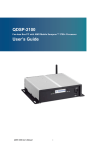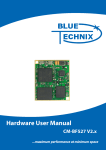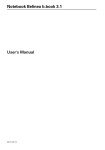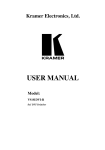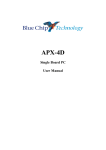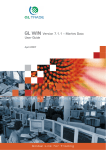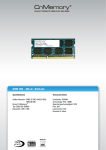Download AR-B7230 BOARD User`s Manual
Transcript
AR-B7230 User’s Manual AR-B7230 BOARD EPIC SBC support AMD Socket S1 Turion and Sempron processors with Dual Gigabit LANs / LCD / DVI User’s Manual Manual Rev: 1.0 Book Number: AR-B7230-09.2.13 1 AR-B7230 User’s Manual Revision Version Date Author Description 0.1 2009/2/11 Marc Draft 0.2 2009/2/13 Judy Tseng Revise 1.0 2009/2/13 Marc Release 2 AR-B7230 User’s Manual @Copyright 2008 All Rights Reserved. Manual’s first edition: February 11, 2009 For the purpose of improving reliability, design and function, the information in this document is subject to change without prior notice, which does not represent a commitment on the part of the manufacturer. In no event will the manufacturer be liable for direct, indirect, special, incidental, or consequential damages arising out of the use or inability to use the product or documentation, even if advised of the possibility of such damages. This document contains proprietary information protected by copyright. All rights are reserved. No part of this Manual may be reproduced by any mechanical, electronic, or other means in any form without prior written permission of the manufacturer. Trademarks AR-B7230 is registered trademarks of Acrosser, IBM PC is a registered trademark of International Business Machines Corporation. Pentium is a registered trademark of Intel Technologies, Inc. Award is registered trademarks of Award Software International, Inc. Other product names mentioned herein are used for identification purposes only and may be trademarks and/or registered trademarks of their respective companies. 3 AR-B7230 User’s Manual Table of Contents 1.1 Specifications .................................................................................................................. 7 1.2 Package Contents ............................................................................................................ 9 1.3 Block Diagram .............................................................................................................. 10 2.1 Locations (Top side) ...................................................................................................... 11 2.2 Locations (Bottom Side)................................................................................................ 13 2.3 Connectors and Jumper Setting ..................................................................................... 13 2.3.1 CN1 (USB Port 3,2) ............................................................................................... 13 2.3.2 CN2 (USB Port 5,4) ............................................................................................... 14 2.3.3 CN3 (Audio Port) ................................................................................................... 14 2.3.4 SATA1 Power (Output) .......................................................................................... 14 2.3.5 COM2 (Serial Port 2) ............................................................................................. 14 2.3.6 COM3 (Serial Port 3) ............................................................................................. 15 2.3.7 CN6 (PWR.SW, Reset, CaseOpen, GPIO) ............................................................. 15 2.3.8 CN7 (ATX Power SB5V Input) ............................................................................. 15 2.3.9 CN8 (Backlight Power Output) .............................................................................. 15 2.3.10 CN10 (Power +12V Input) ................................................................................... 15 2.3.11 COM4 (Serial Port 4) ........................................................................................... 16 2.3.12 AUDIO1 (Audio output connector) ...................................................................... 16 2.3.13 FAN1 (CPU / System Fan) ................................................................................... 16 2.3.14 FAN2 (System / CPU Fan) ................................................................................... 17 2.3.15 GPIO1 (Digital I/O) .............................................................................................. 17 2.3.16 DVI1 (Digital Visual Interface) ............................................................................ 17 2.3.17 LVDS1.................................................................................................................. 17 4 AR-B7230 User’s Manual 2.3.18 BAT1 (Extrnal Battery Input) .............................................................................. 18 2.3.19 IDE1 ..................................................................................................................... 18 2.3.20 PS2 (Keyboard & Mouse) .................................................................................... 18 2.3.21 J1 .......................................................................................................................... 18 2.3.22 J2 .......................................................................................................................... 18 2.3.23 J3 .......................................................................................................................... 19 2.3.24 J4 .......................................................................................................................... 19 2.3.25 J5 .......................................................................................................................... 19 2.3.26 J6 .......................................................................................................................... 19 2.3.27 J7 .......................................................................................................................... 19 3.1 Main Setup .................................................................................................................... 21 3.2 Advanced Chipset Setup................................................................................................ 22 3.3 PnP/PCI setup ................................................................................................................ 24 3.4 Peripherals Setup ........................................................................................................... 26 3.5 PC Health Setup ............................................................................................................ 27 3.6 Boot Setup ..................................................................................................................... 28 3.7 Exit Setup ...................................................................................................................... 29 5 AR-B7230 User’s Manual 1 INTRODUCTION Welcome to the AR-7230 Computer. The AR-7230 incorporates the advanced AMD® M690E & SB600 chipset. It supports the AMD Socket S1 Turion 64 X2 and Sempron Processors, while coming with a 400/533MHz Front Side Bus. The AR-B7230 is a Complete Platform that totally supports EPIC form factor SBC. 6 AR-B7230 User’s Manual 1.1 Specifications CPU : AMD Socket S1 Turion 64 X2 and Sempron Processors Turion 64 X2 TL62 Turion 64 X2 TL56 Mobile AMD Sempron 3700+ Mobile AMD Sempron 3500+ Mobile AMD Sempron 2100+ AMD Sempron 2100+ z Chipset : AMD M690E Integrated Graphic Processor (IGP) and SB600 South Bridge z BIOS: AWARD z RAM memory : One SO-DIMM socket support DDR2 SDRAM up to 2GB Supports DDR2-400 up to DDR2-667 z Watchdog Timer : Software programmable 1~255 Seconds (Wait RD confirm) z Battery : Lithium Battery, 3V 220Mah z Power Requirements : AT: 12V Single Voltage Input (BIOS Default) , ATX: power switch pin header and pin header for external 5V stand-by input z Hardware monitoring : 1. CPU voltage 2. CPU and System Temperature z LED : 2 LEDs for Power and HDD. Power LED (Green), HDD (Orange) z Button : Reset button (use pin header) z Fan connector : 1. 1 x CPU fan 2. 1 x System Fan with temperature controller (connector color different from CPU Fan connector) z OS : Win XP/XP Embedded, Linux, Vista Video z Graphic Controller : AMD M680E integrated graphic processor (IGP) 2D, 3D and Motion Video acceleration Dual Independent Display Frame Buffer shared from system memory up to 256MB Full DirectX 9.0 and Shader Model 2.0 support z VGA : 1 x VGA port z DVI : 1 x DVI-D port 7 AR-B7230 User’s Manual z LCD : 1 x Dual Channel 18bits LVDS Interface LCD inverter power connector and ON/OFF control Support 3.3V and 5V LCD AUDIO z Audio Interface : 5.1 CH Audio Realtek ALC655 AC’97 Rev.2.3 with amp. Storage z IDE : 1 x E-IDE z SSD : 1 x Compactflash Type-II support UDMA 1 x SATA DOM connector z FDC : N/A z SATA : 1 x SATA HDD and one SATA DOM interface Network Interface z Ethernet : 2 x BCM5787 PCI express Giga bps Ethernet LAN Support boot from LAN & WOL I/O z Serial Port : 1 x RS-232 (COM1) 2 x RS-232 (COM2/3) 1 x RS-232/422/485 (COM4) z Parallel Port : 1 x LPT supports SPP/EPP/ECP modes z GPIO : 8 Independent TTL level I/O z USB : 2 x External ports (Stacked Type A) z Audio : 5.1 CH Audio z Expansion slot : 1 x PCI-104 (PCI Interface) z Keyboard / Mouse : 1 x PS/2 for Keyboard and Mouse Mechanical z Dimension : 115mm x 165mm (4.528 x 6.496 inches) z Operating Temperature : 0~60oC (32~140oF) z z Storage Temperature : -20~80oC (-4~176oF) Relative Humidity : 0 to 90% @ 40°C, non-condensing (95% @ 40°C, Non-Condensing by request) EMC & Safety z EMC : CE, FCC Class A Notes: CF must be surfaced with PCB edge. Dual Display CRT+LCD, DVI+LCD, CRT+DVI 8 AR-B7230 User’s Manual 1.2 Package Contents Check if the following items are included in the package. z The quick manual z AR-B7230 z 1 software utility CD z Cooler Optional EPIC Cable Sets (Purchase Separately) z Power Cable (AT) z Power Cable (ATX) z 40/44-Pin IDE Cable z LPT Cable z K/M Cable z Audio Cable (Stereo) z USB Cable (with 4 screws) z COM Cable (10-Pin) x2 z SATA cable z DVI cable Optional Cable (Purchase Separately) z Audio Cable (5.1CH) 9 AR-B7230 User’s Manual 1.3 Block Diagram AMD S1g1 PROCESSOR 638-Pin uFCPGA LVDS CON LVDS TVOUT CON SVIDEO/COMP VGA CON CRT 200-PIN DDR2 SODIMM IN HyperTransport LINK0 ICS951462 OUT EXTERNAL CLOCK GENERATOR UNBUFFERED DDR2 NEAR SODIM M DDR2 400/533/667 16x16 UNBUFFERED DDR2 FAR SODIM M ATI NB - RS690T/485T 200-PIN DDR2 SODIMM HyperTransport LINK0 CPU I/F INTEGRATED GRAPHICS DDR2 MEMORY (X16) LVDS/TVOUT/TMDS 1 X8 PCIE VIDEO/DDP2 I/F P CIE x 8DVI DVI CON DDR2 400/533/667/800 DDR2 M EM ORY DEVICE 4M X16X4 84-PIN FBGA 1 X4 PCIE I/F WITH SB 4(2) X1 PCIE I/F X1 P CIE IN T ERFACE BOOTSTRAPS (NB) PCIE PCIE ETHERNET -2 PCIE ETHERNET -1 X4 AC LINK I/F ATI SB - SB600 USB#4 USB#3 USB#2 USB#1 USB#0 USB 2.0 USB#8 USB#7 USB#6 AZALIA HD AUDIO USB#5 SPI I/F SPI I/F INT RTC LPC BUS SATA#1 SATA II I/F SATA#2 SATA#3 ATA 66/100/133 I/F IDE CONNECTOR HW M ONITOR I/F HW M ONITOR HW MONITOR PCI/PCI BDGE FLASH BIOS LPT SATA#0 LPC I/F ACPI 1.1 ITE LPC SIO 8712F SATA II I/F AC97 2.3 ATA 66/100/133 SPI ROM CONNECTOR USB2.0 (10) SATA II (4 PORTS) USB#9 AC97 SERIAL KBD M OUSE PORT PCI 104 BOOTSTRAPS (SB) Figure 1: Black Diagram 10 CF AR-B7230 User’s Manual 2 H/W INFORMATION This chapter describes the installation of AR-B7230. At first, it shows the Function diagram and the layout of AR-B7230. It then describes the unpacking information which you should be careful with, as well as the jumper/switch settings for the AR-B7230 configuration 2.1 Locations (Top side) J3 GPIO1 CN2 SL1(PCI104) J4 J4 U1 BAT2 SL1 FAN 1 FAN1 LVD S1 D VI1 B IOS BZ1 PRN1 C OM2 J2 U 10 GPIO1 C N 2 CN8 C N3 C N 6 J3 C OM1 COM1 IDE1 J5 C N 10 P6 P7 P8 CN1 BAT1 P8 DVI1 CN9 COM2 COM3 COM4 J7 J6 J1 U SB 1 P10 PRN1 P10 P6 P7 Figure 2: Locations (Top side) 11 USB1 IDE1 B AT1 CN1 CN9 J2 J7 J6 J1 J5 COM4 LVDS1 CN5 CN8 CN6 CN3 CN7 COM3 CN10 SATA1 FAN 2 CN5 FAN2 CN7 BAT2 SATA1 C PU AR-B7230 User’s Manual CN1 USB Port 3,2 IDE1 CN2 USB Port 5,4 P8 PS2 Keyboard & Mouse CN3 Audio Port J1 Clear CMOS CN5 SATA1 Power (Output) J2 ENABLE SPI/DEBUG COM2 Serial Port 2 J3 RS-232/422/485 SELECT COM3 Serial Port 3 J4 SERIRQ to SL1 Pin B1 CN6 PWR.SW, Reset, CaseOpen, GPIO J5 LCD POWER SELECT CN7 ATX Power SB5V Input J6 CF MASTER/SLAVE SELECT CN8 Backlight Power (Output) J7 CF DMA SELECT CN10 Power +12V (Input) COM4 Serial Port 4 PRN1 Parallel Port FAN1 CPU / System Fan FAN2 System / CPU Fan GPIO1 Digital I/O DVI1 Digital Visual Interface LVDS1 BAT1 External Battery Input 12 AR-B7230 User’s Manual 2.2 Locations (Bottom Side) Figure 3: Locations (Bottom side) 2.3 Connectors and Jumper Setting 2.3.1 CN1 (USB Port 3,2) 10 2 9 1 13 PIN SIGNAL PIN SIGNAL 1 +5V 6 D2+ 2 +5V 7 GND 3 D3- 8 GND 4 D2- 9 GND 5 D3+ 10 GND AR-B7230 User’s Manual 2.3.2 CN2 (USB Port 5,4) 10 2 9 1 PIN SIGNAL PIN SIGNAL 1 +5V 6 D4+ 2 +5V 7 GND 3 D5- 8 GND 4 D4- 9 GND 5 D5+ 10 GND PIN SIGNAL PIN SIGNAL 1 R-OUT 8 A-GND 2 L-OUT 9 A-GND 3 A-GND 10 A-GND 4 A-GND 11 SR-OUT 5 R-IN 12 SL-OUT 6 L-IN 13 LFT-OUT 7 MIC-IN 14 SEN-OUT 2.3.3 CN3 (Audio Port) 14 13 2 1 2.3.4 SATA1 Power (Output) PIN SIGNAL 1 1 +12V 4 2 GND 3 +3.3V 4 +5V 2.3.5 COM2 (Serial Port 2) 2 10 1 9 14 PIN SIGNAL PIN SIGNAL 1 DCD2 6 CTS2 2 DSR2 7 DTR2 3 RX2 8 RI2 4 RTS2 9 GND 5 TX2 10 NC AR-B7230 User’s Manual 2.3.6 COM3 (Serial Port 3) 2 10 1 9 PIN SIGNAL PIN SIGNAL 1 DCD3 6 CTS3 2 DSR3 7 DTR3 3 RX3 8 RI3 4 RTS3 9 GND 5 TX3 10 NC PIN SIGNAL PIN SIGNAL 1 POSW 5 CASE 2 GND 6 GND 3 REST 7 GPIO 4 GND 8 GND 2.3.7 CN6 (PWR.SW, Reset, CaseOpen, GPIO) 2 8 1 7 2.3.8 CN7 (ATX Power SB5V Input) 1 3 PIN SIGNAL 1 GND 2 PSON 3 5VSB 2.3.9 CN8 (Backlight Power Output) 1 6 PIN SIGNAL PIN SIGNAL 1 +12V 4 BLEN 2 +12V 5 GND 3 GND 6 BLON 2.3.10 CN10 (Power +12V Input) 2 4 1 3 15 PIN SIGNAL 1 GND 2 +12V 3 GND 4 +12V AR-B7230 User’s Manual 2.3.11 COM4 (Serial Port 4) PIN SIGNAL PIN SIGNAL 1 DCD3 8 RI3 2 DSR3 9 GND 2 14 3 RX3 10 NC 1 13 4 RTS3 11 TX+ 5 TX3 12 TX- 6 CTS3 13 RX+ 7 DTR3 14 RX- PIN SIGNAL PIN SIGNAL 1 STB 14 GND 2 AFD 15 D6 3 D0 16 GND 4 ERR 17 D7 5 D1 18 GND 2.3.12 AUDIO1 (Audio output connector) 2 26 6 INIT 19 ACK 1 25 7 D2 20 GND 8 SLIN 21 BUSY 9 D3 22 GND 10 GND 23 PE 11 D4 24 GND 12 GND 25 SLCT 13 D5 26 NC 2.3.13 FAN1 (CPU / System Fan) 4 1 16 PIN SIGNAL 1 GND 2 +12V 3 DET. 4 CTL. AR-B7230 User’s Manual 2.3.14 FAN2 (System / CPU Fan) PIN SIGNAL 1 GND 2 FAN2 3 DET. 3 1 2.3.15 GPIO1 (Digital I/O) 10 2 9 1 PIN SIGNAL PIN SIGNAL 1 DIO0 6 DIO6 2 +5V 7 DIO3 3 DIO1 8 DIO5 4 DIO7 9 GND 5 DIO2 10 DIO4 PIN SIGNAL PIN SIGNAL 1 GND 14 I2CK 2 TX0+ 15 +5V 3 TX0- 16 I2DT 4 GND 17 RED 5 TX1+ 18 GND 6 TX1- 19 GREEN 7 GND 20 GND 8 TX2+ 21 BLUE 9 TX2- 22 GND 10 GND 23 VSYNC 11 TXC+ 24 CLK 12 TXC- 25 HSYNC 13 HPD 26 DAT 2.3.16 DVI1 (Digital Visual Interface) 1 2 25 26 2.3.17 LVDS1 1 2 29 30 PIN SIGNAL PIN SIGNAL PIN SIGNAL 1 +VDD 11 U3+ 21 I2CLK 2 GND 12 U3- 22 L1+ 3 UCK- 13 U0+ 23 L1- 4 UCK+ 14 U0- 24 I2DAT 5 GND 15 GND 25 L0+ 17 AR-B7230 User’s Manual 6 U2- 16 LCK+ 26 L0- 7 U2+ 17 LCK- 27 L3+ 8 GND 18 GND 28 L3- 9 U1- 19 L2+ 29 +VDD 10 U1+ 20 L2- 30 +VDD 2.3.18 BAT1 (External Battery Input) 1 PIN SIGNAL 1 3VIN 2 GND 2 2.3.19 IDE1 44 43 2 PIN SIGNAL PIN SIGNAL PIN SIGNAL PIN SIGNAL 1 RST- 12 D12 23 IOW- 34 DMA66- 2 GND 13 D2 24 GND 35 A0 3 D7 14 D13 25 IOR- 36 A2 4 D8 15 D1 26 GND 37 CS0- 5 D6 16 D14 27 IRDY 38 CS1- 6 D9 17 D0 28 CSEL 39 ACT- 7 D5 18 D15 29 DACK- 40 GND 8 D10 19 GND 30 GND 41 +5V 9 D4 20 NC 31 IRQ 42 +5V 10 D11 21 DREQ- 32 NC 43 GND 11 D3 22 GND 33 A1 44 NC 1 2.3.20 PS2 (Keyboard & Mouse) 6 5 4 3 2 1 PIN SIGNAL PIN SIGNAL 1 KBDAT 4 +5V 2 MSDAT 5 KBCLK 3 GND 6 MSCLK 2.3.21 J1 (Default) 1-2 Short, Normal 2-3 Short, Clear CMOS 1 3 2.3.22 J2 7 1 8 2 (Default) 1-2 Short, SPI ENABLE 3~8 SIGNAL DEBUG CHECK 18 AR-B7230 User’s Manual 2.3.23 J3 2 6 1 5 (Default) 1-2 Short, COM4=RS232 3-4 Short, COM4=RS422 5-6 Short, COM4=RS485 2.3.24 J4 (Default) 1-2 Short,SERIRQ to SL1 Pin B1 2 1 2.3.25 J5 3 1 (Default) 1-2 Short, LCD Power=3.3V 2-3 Short, LCD Power=5.0V 2.3.26 J6 (Default) Short, CF is Master Open, CF is Slave 1 2 2.3.27 J7 3 1 (Default) 1-2 Short, CF is DMA66 support 19 AR-B7230 User’s Manual 3 BIOS SETTING This chapter describes the BIOS menu displays and explains how to perform common tasks needed to get up and running. It also gives detailed explanation of the elements found in each of the BIOS menus. The following topics are covered: z Main Setup z Advanced Chipset Setup z Peripherals Setup z PnP/PCI Setup z PC Health Setup z Boot Setup z Exit Setup 20 AR-B7230 User’s Manual 3.1 Main Setup Once you enter the Award BIOS™ CMOS Setup Utility, the Main Menu will appear on the screen. Use the arrow keys to highlight the item and then use the <Pg Up> <Pg Dn> keys to select the value. You want in each item. Figure 4: Main setup Note : Listed at the bottom of the menu are the control keys. If you need any help with the item fields, you can press the <F1> key, and it will display the relevant information. Option Choice Description Date Setup N/A Set the system date. Note that the ‘Day’ automatically changes when you set the date Time Setup N/A Set the system time IDE Channel 0 Master/Slave N/A The onboard PCI IDE connectors provide 1 channel for connecting up to 2 IDE hard disks or other devices. The first is the “Master” and the second is “Slave”, BIOS will auto-detect the IDE type. Halt On All Errors, No Errors, All but keyboard. Select the situation in which you want the BIOS to stop the POST process and notify you. 21 AR-B7230 User’s Manual 3.2 Advanced Chipset Setup Figure 5: Advance chipset setup Option Choice Description Quick Power On Self Test Enabled Disabled This category speeds up Power On Self Test (POST) after you have powered up the computer. If it is set to Enable, BIOS will shorten or skip some check items during POST. Full Screen Logo Show Enabled Disabled Select Enabled to show the OEM full screen logo if you have add-in BIOS. USB Keyboard Support Enabled Disabled Select Enabled if your system contains a Universal Serial Bus (USB)controller and you have a USB keyboard.. On-Chip Frame Buffer Size 1Mb 8Mb Boot Display CRT LCD CRT+LCD TV Panel Type 800x600, 1024x768, 1280x1024 This Item is for setting the Frame Buffer (Share system memory as display memory). This Item is to set display device This Item can Set the LVDS panel resolution that you want 22 AR-B7230 User’s Manual DVMT mode FIXED DVMT Both This item sets the mode for dynamic video memory technology (DVMT). DVMT/FIXED Memory Size 64Mb 128Mb This item sets the DVMT size 23 AR-B7230 User’s Manual 3.3 PnP/PCI setup Figure 6: PnP/PCI setup Option Reset Configuration Data Resources Controlled By Choice Description Enabled Disabled Normally, you leave this field Disabled. Select Enabled to reset Extended System Configuration Data (ESCD) when you exit Setup. If you have installed a new add-on and the system reconfiguration has caused such a serious conflict, then the operating system can not boot. Auto (ESCD) Manual The Award Plug and Play BIOS has the capacity to automatically configure all of the boot and Plug and Play compatible devices. However, this capability means absolutely nothing unless you are using a Plug and Play operating system such as Windows 95. If you set this field to “manual,” then you may choose specific resources by going into each of the submenus. 24 AR-B7230 User’s Manual IRQ Resources When resources are controlled manually, assign a type to each system interrupt, depending on the type of the device that uses the interrupt N/A 25 AR-B7230 User’s Manual 3.4 Peripherals Setup Figure 7: Peripherals setup Option Choice Description Onboard Serial Port 1 Onboard Serial Port 2 Onboard Serial Port 3 Onboard Serial Port 4 Serial Port 1: 3F8 / IRQ4 Serial Port 2: 2F8 / IRQ3 Serial Port 3: 3E8 / IRQ11 Serial Port 4: 2E8 / IRQ10 Select an address and the corresponding interrupt for each serial port Enabled Disabled Select Enabled if your system contains a Universal Serial Bus (USB) controller and you have USB peripherals USB 2.0 Controller Enabled Disabled Select Enabled if your system contains a Universal Serial Bus (USB) 2.0 controller and you have USB peripherals AC97 Audio Function Enabled Disabled Audio/Modem This item allows you to decide to enable/disable AC97 Audio USB Controller On chip IDE DEVICE The integrated peripheral controller contains an IDE interface with support for two IDE channels. Select Enabled to activate each Enabled Disabled 26 AR-B7230 User’s Manual channel separately. 3.5 PC Health Setup This section shows the parameters in determining the PC Health Status. These parameters include temperatures, fan speeds, and voltages. Figure 8: PC health setup 27 AR-B7230 User’s Manual 3.6 Boot Setup Figure 9: Boot setup Option Choice Description First / Second / Third Boot Device/Other Boot Device Hard Disk CDROM USB-FDD USB-CDROM LAN Disabled The BIOS attempts to load the operating system from the devices in the sequence selected in these items. LAN Boot Select Enabled Disabled These fields allow the system to search for an OS from LAN Hard Disk Boot Priority N/A 28 These fields set the Boot Priority for each Hard Disk AR-B7230 User’s Manual 3.7 Exit Setup Figure 10: Exit setup Option Save & Exit Setup Load Optimized Defaults Choice Description Pressing <Enter> on this item for confirmation: Save to CMOS and EXIT (Y/N)? Y When you press <Enter> on this item you get a confirmation dialog box with a message like this: Load Optimized Defaults (Y/N) ? N 29 Press “Y” to store the selections made in the menus in CMOS – a special section of memory that stays on after you turn your system off. The next time you boot your computer, the BIOS configures your system according to the Setup selections stored in CMOS. After saving the values the system is restarted again Press ‘Y’ to load the default values that are factory-set for optimal-performance system operations. AR-B7230 User’s Manual Exit Without Saving Pressing <Enter> on this item for confirmation: Quit without saving (Y/N)? Y This allows you to exit Setup without storing any changes in CMOS. The previous selections remain in effect. This shall exit the Setup utility and restart your computer. When a password has been enabled, you will be prompted to enter your password every time you try to enter Setup. This prevents unauthorized persons from changing any part of your system configuration. Type the password, up to eight characters in length, and press <Enter>. The password typed now Set Password Pressing <Enter> on this item for confirmation: ENTER PASSWORD: will clear any previous password from the CMOS memory. You will be asked to confirm the password. Type the password again and press <Enter>. You may also press <Esc> to abort the selection and not enter a password. To disable a password, just press <Enter> when you are prompted to enter the password. A message will confirm that the password will be disabled. Once the password is disabled, the system will boot and you can enter Setup freely. 30






























